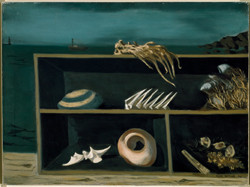New York in the 1940s
13 Jun - 08 Sep 2008

© Adolph Gottlieb
The Sea Chest, 1942
Oil on canvas,
66 x 86.6 cm
Solomon R. Guggenheim Museum, New York 48.1172.510
The Sea Chest, 1942
Oil on canvas,
66 x 86.6 cm
Solomon R. Guggenheim Museum, New York 48.1172.510
NEW YORK IN THE 1940s
Selections from the Collection
June 13–September 8, 2008
With the outbreak of World War II, numerous European artists, including many Surrealists, sought refuge in New York. Here, they exhibited at the Julian Levy Gallery, Peggy Guggenheim’s Art of This Century, the Nierendorf Gallery, and Albert Gallatin’s Museum of Living Art at New York University, as well as the Museum of Modern Art and the Guggenheim’s forerunner, the Museum of Non-Objective Painting, allowing an emerging vanguard of American painters to encounter the European avant-garde.
Among the prominent émigrés from this era was Wolfgang Paalen, a Surrealist artist who spent the 1940s in New York, California, and Mexico. In 1942, Paalen published his essay “Farewell to Surrealism” in the first issue of DYN, an art journal he founded. Publicly parting with the founder of Surrealism André Breton, Paalen devoted his journal primarily to the new generation of American abstract painters—including William Baziotes, Robert Motherwell, and Jackson Pollock—who valued Surrealism’s aesthetic paths to the unconscious. Breton, in response, founded VVV, edited by David Hare, with collaborators Marcel Duchamp and Max Ernst. Published in New York, the journal became a vehicle for European artist émigrés to communicate with young American artists.
The nascent New York School took inspiration from diverse sources: the biomorphic and pictographic work of early Surrealists as well as their later, increasingly abstract experiments with automatism; primitive myths and ancient cultures; totemism; and Jungian thought and archetypes. The new American painters, including Baziotes, Adolph Gottlieb, and Mark Rothko, mined myth and art history for imagery and subject matter that summoned the collective unconscious or spiritual authenticity. The free-form automatic writing and drawing of the Surrealists gave way to dynamic gesture, in which the act of painting could be traced in the completed canvas, as in more mature Abstract Expressionist works by Franz Kline and Pollock. A number of these canvases also show traces of Regionalism—representations of oft-romanticized subjects by artists such as Thomas Hart Benton, Reginald Marsh, and Grant Wood.
The paintings and sculptures on view, by artists working or showing in New York in the 1940s, reveal a time of transition, and exchange between generations (it was also the time the artist Louise Bourgeois first arrived in the city).
Selections from the Collection
June 13–September 8, 2008
With the outbreak of World War II, numerous European artists, including many Surrealists, sought refuge in New York. Here, they exhibited at the Julian Levy Gallery, Peggy Guggenheim’s Art of This Century, the Nierendorf Gallery, and Albert Gallatin’s Museum of Living Art at New York University, as well as the Museum of Modern Art and the Guggenheim’s forerunner, the Museum of Non-Objective Painting, allowing an emerging vanguard of American painters to encounter the European avant-garde.
Among the prominent émigrés from this era was Wolfgang Paalen, a Surrealist artist who spent the 1940s in New York, California, and Mexico. In 1942, Paalen published his essay “Farewell to Surrealism” in the first issue of DYN, an art journal he founded. Publicly parting with the founder of Surrealism André Breton, Paalen devoted his journal primarily to the new generation of American abstract painters—including William Baziotes, Robert Motherwell, and Jackson Pollock—who valued Surrealism’s aesthetic paths to the unconscious. Breton, in response, founded VVV, edited by David Hare, with collaborators Marcel Duchamp and Max Ernst. Published in New York, the journal became a vehicle for European artist émigrés to communicate with young American artists.
The nascent New York School took inspiration from diverse sources: the biomorphic and pictographic work of early Surrealists as well as their later, increasingly abstract experiments with automatism; primitive myths and ancient cultures; totemism; and Jungian thought and archetypes. The new American painters, including Baziotes, Adolph Gottlieb, and Mark Rothko, mined myth and art history for imagery and subject matter that summoned the collective unconscious or spiritual authenticity. The free-form automatic writing and drawing of the Surrealists gave way to dynamic gesture, in which the act of painting could be traced in the completed canvas, as in more mature Abstract Expressionist works by Franz Kline and Pollock. A number of these canvases also show traces of Regionalism—representations of oft-romanticized subjects by artists such as Thomas Hart Benton, Reginald Marsh, and Grant Wood.
The paintings and sculptures on view, by artists working or showing in New York in the 1940s, reveal a time of transition, and exchange between generations (it was also the time the artist Louise Bourgeois first arrived in the city).
